Trango Towers, the BASE jump by Andrey Lebedev and Vladimir Murzaev
Following the Australian pioneers Glenn Singleman and Nic Feteris: the story of the Great Trango Tower BASE jump carried out by Andrey Lebedev and Vladimir Murzaev on 10 August 2013.
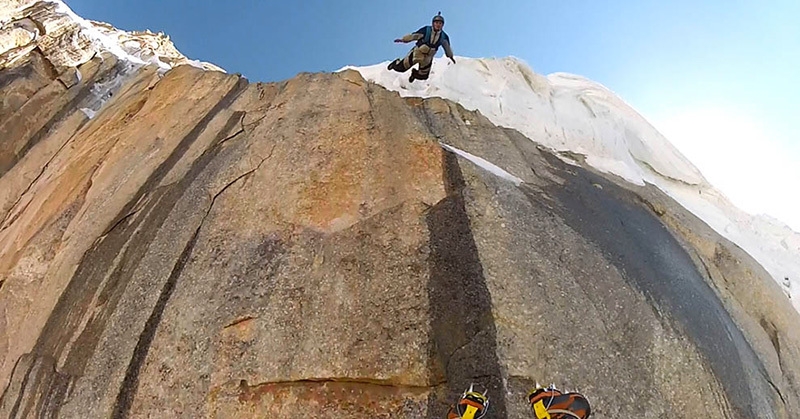
 1 / 9
1 / 9
Andrey Lebedev and Vladimir Murzaev, Trango Towers BASE Jump, Pakistan
For me the story began something like 4 years ago when I got my hands on an article in 96’ issue of “Vertical World' magazine about the jump from the Trango Towers, one of the highest verticals on the planet. Two Australians: Glenn Singleman and Nic Feteris came up with the idea of jumping there and made the expedition come true. The photos of the guys frozen in the moment of the leap from the wall, backgrounded by the rocks and the snow on the cover made an even greater impression. The picture strongly carved in my memory. I was just start to base-jump at that time. After some time I saw the movie about the jump and it made my urge to jump there unavoidable.
The decision to jump from Trango Towers was quite unexpected. A year ago we were talking about the Trango with Vova Murzaev. The essence of the conversation was quite simple:
- The guys did a pretty stunning jump.
- Awesome stuff!
- I think I want to jump that wall as well.
- Yeah, me too.
- Let’s do that then!
Acting is different from talking. Actual preparations started only two months before the trip. First of all, the question was how to get there. We started asking climber friends who have been to Karakorum, gathering the information. Then we arranged the visas and tickets and figured out equipment issues. Sometimes I caught myself on thoughts and doubts that we're not just discussing the expedition but we are actually going to go to Pakistan to jump the Trango Tower. Sometimes it even gave me some awkward feeling. But the need to do that was greater and the preparations continued.
First of all I want to clear some points to make the circumstances of our expedition obvious. At first, alpinism is not our strong skill. Both of us have been to mountains one and a half time each on newbie routes. We're familiar with the ropes though. On the other hand we're neither sponsored nor funded in any significant way which means minimal amount of new equipment, most of it has been borrowed from our friends. We had to cut on logistics and food. At last there were just two of us though we had invited some guys. Someone wanted to join us but couldn’t others could but didn’t really want. However, though there were just two of us with no support, we were free to decide and arrange things.
Being short on finance makes us rely on ourselves but at the last minute we get that it’s not allowed to go to the mountains without a permit and a guide. I receive the costs of a tour operator the day before the departure to Islamabad. Islamabad meets us with a moist and hot air. Feels like at sauna. Having never met the tour operator guys at Islamabad we're taking a flight to Skardu, hoping that we can arrange things there, but it appears that the arrangements should have been made in Islamabad. Being hung between things for some time we figure out that the wish of a tour operator to take their toll overcomes the formalities. Next day we have our 23 years old guide Javed with a heap of necessary papers. The formal part is over and we hire an off-road car to Askole, the last village on the map before the track starts. The weather is above expectations. We are enjoying the views of snowy mountains while the road conditions start to get from bad to worse: in the beginning we have good flat asphalt, but the last third doesn’t resemble a road at all. We wonder if it’s even possible to get through by car. Some of the rivers are crossed fording while the major rivers are crossed over by hanging bridges swinging from side to side while you go. Six hours of the road like this make us exhausted as hell. A lot of porters offering their service gather up at Askole but there are just 100 kg of stuff for three of us – not much compared to other expeditions. We come up with 2 porters which take 25 kg's each. Expecting to cut on porters I and Vova take 25 kilo's backpacks each as well. We decide to save time and not to stay in Askole for the night, as soon as the heat of the clear day begins to fall we leave Askole for hike.
The first three hour hike comes hard, but true. Keeping in mind that we didn't have any training before the trip and the weight of the backpacks on the height over 3000 m - we do well. But not as well as we should. I feel really tired next afternoon and we have to drop most of our gear to the accident porters going to K2 base camp with another expedition. I go with almost nothing and Vova with 10 kilos of gear left on his back. Two more hours and I’m done. It is clear that I simply can’t go on. We decided to sleep on the hike path, one hour walk away from the camp. Luckily we have our sleeping bags and mattresses with porters after us. We take the necessary and ask for a couple of chapatis – bread tortillas, and send the guide to the camp promising we're going to catch up next morning. Night under the stars. Despite the exhaustion sleep is poor and shallow. The moon is rising around the midnight and lighting up the opposite slopes which are surrounded by thin line of clouds. We wake up at 4 am. The body recovered a bit and is able to walk but we get to the camp only around 7 am. By the way, all the distances are measured depending on time and what has been promised as an hour walk we do in two. And there was no way for me to make that path yesterday. The camp surprises us: a small oasis with small trees and small buildings that give shelter from a burning sun. We stay until the next day to recover and get ourselves together. We feel better and get bored in the daytime while all our thoughts are forward to the six-hour-walk base camp. Early wake-up again. We don’t want to wake up at all but the fact that it’s going to be easier to cover the distance between 4 and 9 a.m. while it is fresh and cool gets us up. Breakfast with locals, they welcome us with chapatis and baltitea – traditional tea boiled on milk with a good portion of salt and butter. Curiosity keeps me for just half of a cup. We move out in the dark. The whole path goes along the canyon with the river Baltoro that flows from the glacier of the same name. We get to that place, then the path goes to the glacier. After an hour walk on the Baltoro glacier we have to take left heading for the Trango glacier. The view at all Trango massive opens slowly in front of us. Just cannot fit the whole depth of the view that has been just a picture on a desktop of my home PC. Is it for real the Great Trango Tower in front of my eyes? It is unbelievable that I’m actually here! Back home I set 3 stages of our journey, one under the other: get to the base camp and see the Trango – climb the Main Tower – perform the jump from it. And it would be a success to complete just the first one.
Finally we're at the base camp. It’s on a bank of a huge mountain lake which is right under the enormous granite wall of the base of Trango Ri, the highest point of that massif. Three groups are already there: two guys from Poland, we've met them at Skardu already - their plan is to climb the Main Tower; four Korean girls that have already took the route to the Nameless Tower and Russian guys from Irkutsk - Zhenya Bashkirtsev and Denis Veretenin are also on the Nameless at that moment. We've caught the guys on their planes switch in Moscow and grabbed another handful of information. The guys confirmed the most important thing for us - that it is possible to get to the Main Tower on foot without any tech climbing which was over our ability. Getting up there is a whole other story because it is not a walkabout out of the base camp for a few hours. More like a serious alpinist route on 6000 meters that probably takes more than one day.
We camp there with 2 our small tents; one is for us and the other, tiny single cover one, for stuff and food. We count on it as an assault tent as its weight is just 1 kilo. We spot a few ironical smiles from the local guides and cooks, in a kind way off course, as it’s unusual for them to see that. It’s common to have a lot of porters to carry the base camp stuff like huge tents to make a kitchen-canteen, kerosene cookers, tens of liters of fuel for them, gas lamps, tables, chairs, all kinds of plates and dishes, fresh fruit and chickens – all that you may want there. It gives comfort of living and gives locals chance to earn some extra. But we have what we have, mostly because of our expedition format. And partly by just not knowing common ways here. Even our guide Javed makes a little joke out of our tiny tent:”So, that is going to be my kitchen?”
Need to admit, that people here are kind. Seems there’s no other way in the mountains. As far as most expeditions leave base camp for their assaults for several days or rather several weeks, we become guests to plenty of party dinners. In fact, the locals themselves have fun this particular way: today everybody has lunch at the Poles, and for dinner there’s invitation from the Korean guide, and tomorrow we’ll go to the Russians. Less food is wasted, guides and cooks are pleased, and we are happy. By the way, some of the porters turn a penny by carrying a 1,5 l bottle or two of Coke and then sell it. In Skardu it costs less than a dollar, in Askole - $3, in Trango base camp about $8, and at the foot of K2 – $20.
The South-West wall of the Main Tower of Trango is heading to the base camp, which confuses us a bit because it doesn't look like the wall that the Australian guys jumped. For sure it has approximately 600 meters vertical part but we have expected a lot more from what is called the longest verticals in the world. Is it just the matter of the point of view? On a way there we have seen the south-eastern and south walls but none of them matched. Aman, a guide of a group from Poland in a little chat tells us that there is an assault camp at the base of the Nameless Tower, where the ascent usually starts. They call it ABC Camp. We are heading there to start acclimatization (it`s 1000-1200 meters higher didn’t figure it out more accurate) and to use an opportunity of being at the same massive to see the wall that we came for from a different angle. Aman says that when he was young high-altitude porter he covered the way to the assault camp and back in 5 hours. We're good enough for that as well, aren’t we? =)
Next day we start our climbing up only between 8 and 9 am, hoping that it’s going to be a quick 3-hours run up and 2-hours run down. What amuses the most is that standing in front of a couloir looks like the base of the Nameless Tower is within 300 meters which is actually 1500 m far. Couloir is enormous with the walls of the Main Tower on the right hand, Trango Ri on the left hand and a very beautiful Nameless in front. Slope angles are different, starting from 30 and mostly about 45 degrees. Fresh and steady walk slows down soon and is followed by hardened breath. We walk the distance to what seems like the Nameless more like 200 than 300 meters far. Couloir is exposed to the South and all the way we're cooked under the sun as well as the huge snowfields around. They melt and wash out the rocks that fall on to our heads. Helmets don’t make it much better. In the end I barely move my feet. I stop every 10 meters to catch my breath but it doesn't work much. We spot some people at the camp and it gives us a little motive to get there after all. We get there only after 2pm. Luka from Italy and Silvan, a Swiss guy, meet us at the camp. They’ve just descended from the Nameless and are having a rest before going to the top of the Main Tower. Pure luck! How did they manage to do that? They show the pictures from the Nameless. Yeah, that is exactly what we need! A part of the North wall and it’s vertical, yes that is it! We can see which way the guys are going to ascend. Snow is all around, seems like no climbing is needed. Anyway, if the guys make the route it will give us valuable information first hands. After chatting around and having a little snack we decide to descend. Shadow covered the couloir and apart from that we’ve both started to have a headache. We decide to see each other at our camp tomorrow.
Next afternoon our guys Zhenya and Denis descend from the Nameless. They did Slovenic route. Everybody is glad to see them. The guide makes a flower wreath for each and bakes a pie on a kerosene blowtorch in their honor. Exceptional taste! After a short rest they plan to go to Uli Biaho. Luka and Silvan come back right after. They were up there, all seems doable. We gather for some tea and chat. At the beginning there are some dangerous rocks signed by ropes. The rest is covered with snow which is pretty melted at the cracks. Guys are almost for a month here and did some nice routes. They camp on the other side of a glacier, the other 3 fellow are Italians. They are done here and offer us the rest of their energy bars and we show no refuse indeed. We go to their camp and meet the rest of the guys at the dinner that awaits us at the “genuine Italian restaurant” with guess what? - Spaghetti! Next morning we get a huge bag of energy bars which (as I get a little bit forward) aid us the rest of the way, with a lot of other tasty stuff. Furthermore Silvan gives us 8mm rope, same length as ours but lighter and more compact. It won’t be idle on snow. Big thanks to you, guys!
And when one part of things is clear we have a new set of questions, decisions and actions to concentrate on. If the wall is on the opposite side, we need to go and see it to find a landing zone. We are not sure which way Australian guys made their way up. Probably there is an easy route there. Which side did they camp? If the approach is along that side and the exit point is at same side we need to move our base camp which is tricky to do with only three of us. Besides we don’t know the route. In general, we’ll obviously need to go down the glacier on our side to the Baltoro glacier, then to the left up heading K2, and once more left to the glacier next – Dunge, and again up so we can go round all Trango massif and walk out to the north wall. But it’s all theoretically – soon we’ll find out the real deal.
Our entire trip continues through the lens of that Australian expedition in 1992 in a natural way. 20 years passed by, what changed, what remained untouched? Mountains, certainly mountains and glaciers have hardly altered during that time. There already were the locals and porters, who appear to be a significant factor for large expeditions. 8 person + professional radio guy, cooking crew and 51 porters took their part in that expedition. It is only 2 of us, and we needed 4 porters. The roads became better, for sure. Somewhere there were no bridges, and rivers were crossed ford. The gear has changed much, during this 20 years technical progress allows to implement new materials and technologies into this activity. Difficult for me to understand, what it feels like jumping with seven kilograms on the head as a helmet and a huge film camera. Nowadays we use modern action cameras, which weigh less than 200 gr. In addition, our view of human abilities and limits has shifted. And of course the experience matters, the experience of people, who were overcoming their limits. Glen and Nick were jumping with velcro rigs, which is unacceptable for the conditions, due to modern base-jumping canons. I think, owing to technologies and accumulated experience today we can repeat this jump in our own format. By the way, it was a venture for Glen and Nick in a sense. This jump was 11-th for Glen, and Nick was in mountains for the first time, and he made the acquaintance with alpinism. We often think of and discuss, what kind of the expedition it was here 20 years ago. Where were they, what did they plan? What difficulties did they overcome and what decisions did they make? Yes, we do know something, but it is only the tip of the iceberg. What were their feelings and emotions? What was the weather? Meanwhile, the weather is a substantial external factor to any expedition. We are very lucky with the weather for now!
We are going to scope out the opposite wall. We assume that if we would be able to jump we gonna need some food which we have to leave in advance. We go up to make a quick-made windsock to not screw the landing. We take the mats and sleeping bags as well because there is no way to make it there and back in one day. First third of the way - the Trango glacier – comes out to be the most exhausting. We take the trail first but there is a landslip so we have to go back a bit to get to the glacier. And then it all begins. It’s impossible to go the exact direction; we have to go round the cracks or elevations. There you walk over the alive rocks, then you are drawn in the sand and all the way its 5 meters up or down difference. If you're after the landslide you cannot go back to the trail. Along the trail there comes a 20-30 meter long, 70 degree steep bulky slope as an obstacle. We walk out to the corner where our glacier fits to the main one, find the continued trails that go between the glacier and the cliff walls of Trango Castle. Sometimes here and there are small areas with grass and trees flowered by small pink bloom and with a nice scent of some herbs. There are some empty stopover sites on the way, but people - nobody. It’s good to take a rest at such a place, to stop for a dinner. We walk to the next turn-corner and the trail continues but it comes to an end at one of the stopover places with a memorial nameplate. It is in Norwegian but the essence is clear: it’s dedicated to two Norwegian guys who made first ascent of the eastern wall in 1984 and died on a descent. A date says 1st of August and it is 2nd today. Just imagine 1984! I wasn’t born yet! The wall is commonly called that way – Norwegian. And here comes the ordinary Norwegian weather: all covered with heavy clouds. Still cannot see the wall from that stopover site. We make just a little bit forward and then realize that it’s gonna be dark in approximately an hour. Back to the stopover site! There we find huge foot prints, probably, belonging to the snow leopard. We settle to rest under the overhanging rock but soon are disturbed by the rain. Water collects on the rock, flows down in a tiny stream and drops right on us. We are forced to move under the other side of the rock. I’m in the sleeping bag under the piece of rock, it’s dark around and it is raining – feels as I’m in Norway. I share the thought with Vova and he has the same feeling. That’s just the energy of the place.
We wake up early to see the wall, while the peaks can still be seen under lowering clouds. One and a half hour more, over the glacier with no trail and here it is - a view to the wall! Oh yes, it`s definitely the one!! Beauty! We can see the approximate line of a fall. We don’t get where the guys landed and chose to land on a snow tongue from enormous couloir which starts under the Norwegian wall. There is a pretty flat piece that seems okay for us. As it comes out later guys flew over the Dunge glacier and landed on the other side. It seems that there is no easier route up and the guys went up the same couloirs as we plan. Yet we don’t make the wind sock, which isn’t right but we have confidence that we're gonna make it still. Six more hours to the base camp.
Great, it becomes clearer about how we can do it. In general, we need only to go up, find the exit point and jump. Of course, we want to jump as early as possible, mainly because of the wind, but also it will be nice to have the reserve of time. So, we need to stay overnight in the upper camp to go to assault early in the morning. Furthermore, we decide to divide the pelting into two stages: drag the tents, all the equipment and food at first, and then go with the parachutes. Ok, it is convenient and useful for acclimatization. The only thing is that we’ll have to go on foot a lot – ‘cause if we jump, we’ll need to go up one more time to ladder the assault camp.
The second ascent to ABC camp is easier, but our backpacks are far from being small. We come out at 5, not 9 a.m. like before. It’s good to walk up in the chill of the morning, and what matters more – no rocks falling from above. We decide to stay overnight upwards, for better acclimatization. We don’t know what to do with ourselves from 12 till 5:30 pm. We sit in the burning sun, which is nowhere to hide from, feeling like we are amoebas because of height, slightly suffering from headache, which seems to be a normal fact, we just need to endure. Rocks are falling whistling, sometimes they're real big. But our place is secure, if you keep yourself inside – nothing should arrive from above. We try to go for water and are caught under fire, so we’d rather not walk again. We dig up some ice scraps into a plactic bag, hang it to melt in the sun. We feel the lack of water, but it’s not critical, we’ll consider it next time and collect it lower beforehand. As soon as the sun disappears behind the mountain – it gets cold, one puts on everything he has. It’s dinner time, getting dark at 8 p.m., so we can go to bed. Sleep is surprisingly sound, we get up early, and want to explore the path above, till the beginning of the snow, and drag all the necessary equipment there. This place is good for camp, but we decide that an hour and a half won’t make a big deal for us. The spot features an amazing view of the eastern wall of the Nameless tower, the Slovenian route.
We see the Korean girls’ tent, but now they are down, tired and exhausted, for a couple of days to have a rest, to continue with renewed vigor. So do we – at first, descent to the ABC Camp, and up to 7 o’clock to the base camp. One more step is made. Well, it is all mostly up to the weather which is extremely unusual as local guides say. It’s warm, air is still and just two cloudy days in two weeks with a couple of rains. And this is what scares us: this shouldn’t last long and can get worse pretty soon. Zhenya and Denis are checking the weather all the time too. They get sms messages on a satellite phone every day. "False start is not in our favor" they say. It takes six days to do first route and descend back. And even if the forecast is very promising you cannot predict the weather for a week in the mountains. However guys are off to route the next day. Good luck and be seeing you soon! We decide to take a rest for a day more and then begin the main stage of our expedition. I turn to the mountains in my mind and ask them to let us get there and jump.
9th of August. We get up at 4a.m., quick breakfast and we gear up. We start ascend at 5a.m. Walking seems harder then the first time. We rest shortly and get up to ABC Camp at 9:30 a.m. We carry the rigs, sleeping bags with us and the rest is already up there. We have nothing to do except cooking at ABC. At 5:30 p.m. the sun is behind the rocks and the heat is coming down. Last preparations for tomorrow. I try on the track suit and the rig, with climbing harness and boots with crampons on. We stow up the pilot chute. If it is necessary to explain: tracksuit is pants and a jacket inflatable by upcoming airflow in a fall, expanding the pressure area of a pilot to track away from the cliff if the pilot's body position is at a right angle. First we wanted to jump with no track suits on like they did back in 92 but the safety reasons took over. It’s getting dark at 7:30pm. We wink to the guys on Uli Bjaho with the head lights and go to sleep. The alarm will wake us up at 3:00am.
Day X. No will to wake up. We make tea and porridge inside the tent staying in our sleeping bags. We start ascent in the dark as we’re aware of the route now. It’s still hard to move but there is no headache at least. The Sun is rising. We get to the reserved stuff at the snow edge. We gear up crampons, take the tools and start the ascent. The steep slope is tiring the feet, it’s hard to go in that gear without a good habit and there’s nothing to do with that – we just have to go on. A few times it’s necessary to backup through ice-screws. Vova is leading all the time – it’s easier for me that way. We get to the bridge and the view at the wall opens. There’s a huge overhung ice-and-snow cap. Yes, we need to get around that place. Traverse to the right, not possible to rest there – just keep going. Up and up again. The slope gets from steeper to narrow. Stopped by the crack, we think going around is too far and uncertain. We manage to jump over the narrow part of it by a snow-and-ice bridge while belaying each other. At 10 we get to the suggested place to start descent to the exit-point. Getting to the edge without the rope seems impossible. Steep slope ends with a huge snow ledge that we saw from the bridge. We make a snow anchor with ice-axes. But the snow has started to melt. It is possible to walk to the edge only while the partner is sitting on that anchor. And there you get the view to the abyss that we're up to jump into, even though you cannot see the wall itself. We get to move higher and to the right to descend. Not clear for how deep it can get. We get stuck with making reliable anchor for descent.
There is only a rapidly melting snow to the state of plunging knee-deep. Brains refuse to think clear. Vova suggests examining the crack that is 20 meters far from the edge – it probably has solid ice. And voila! Vova makes a reliable anchor with two ice-screws, getting a bit lower there. We get to the edge at another point and yes, we like it a lot more here. It is sunny and snowy here, even with a good pair of glasses eyes get tired quickly. No wind. The weather gives us a chance. Everything is up to us from that point. It’s pretty uncomfortable and tricky to gear up. The steep slope, penny sized patch that you’ve stomped for yourself, everything is tied up to prevent from rolling down. We have quite a lot of things which we need to take to the jump. So having the crampons on, our tools are with removable tips. And there are ice-screws, carabines, ascenders and some smaller stuff. Some stuff goes to the pockets, some – to the backpack and under the butt; some stuff is wrapped to the legs with a duct tape. And a tracksuit with rig over all that crap. Cargo base-jumping! Here at the top we are going to leave the rope and part of ice-screws. We spend not less than an hour to gear up. Vova is first to descent to the exit. Goes down for 15 meters and fixes an anchor with two ice-screws. I follow. I cannot manage to go further down from that point. I pass the anchor and go 5 meters lower to the huge cornice and from there I can see the part of the rock for next 10 meters. I suppose that the exit-point is over there. It’s scary as hell. Vova cheers me up. I need to go down further.
Fighting with fear, I climb over the cornice and hang on the rope. Damn it, it’s so scary! Some wispy 8-mm rope stretches in addition! And beneath is a real abyss 1,5km deep, and having a parachute on my back doesn’t comfort a bit for some reason. There are huge icicles below the cornice, really don’t want some of them fall onto one’s head. Finally, I stand on the tiny ledge on the rock. I see the wall, it seems to be slightly positive, but it’s possible to jump, and this calms me down. There is a more convenient exit-point for two of us 5 meters to the right, but I can’t get there with pendulum, because the pendulum is short, it’s slippery, scary and I’m almost exhausted. Release the rope, standing on one foot, holding to the icicle with my hands. Scream to Vova: “Rope free!” and also that it is more handy to go down more to the right. He lowers a bit and makes one more anchor point on a remaining ice-screw. From that point I transit on a pendulum and Vova goes lower once more, 2 meters higher than my ledge. Exit-point is less than satisfying, but there is nothing to choose from. We drop a small stone - the only one we can find around. I don’t count – just want to know if the wall is positive. Take the helmet off to check the camera and feel that something has dropped down. Damned, glasses! “Yeah, glasses!” Vova confirms while following its fall with his eyes. So be it, no glasses. However Vova decides to jump without glasses as well. Cannot check each other, self-check. Releasing descender from the rope and taking it inside the fly zipper. I turn around, facing the abyss. My mind gives me: “A little bit more and we're gonna jump, we're almost ready! After a bit we're gonna land and its over!”
We examine the landing zone and revising the jump agenda, altitude to open, special attention for exit. That is the most important now, we don’t want to end up with spontaneous acrobatics.
- Ready?
- Ready!
- Ready, set, go!
I’m trying to throw my body, with all my belongings as accurate as possible - chest into horizon to avoid headdown. Vova is right behind me. Freedom, finally! The terminal speed comes later indeed and it’s trickier to keep stable in those conditions compared to regular conditions. I`m stretching the arms back and keeping the posture to move forward. I see that I’m moving from the wall and turn slightly right. It might be possible to try to fly out to the glacier but I see that I will hardly be able to do it and decide not to risk it – there is no such goal. I’m up to jump-and-survive for this time. Pull pilot chute, parachute opens. I look up – here it is, my treasured old friend, my canopy. I look for Vova - all is good! He's right after me under the canopy. There are still deeps under us, I figure out the wind direction by the cross shift and manage our landing. We land. I grab my canopy and run to Vova. “We made it after all!” Flooded with emotions! We embrace and share what each other has just seen and felt. It is a teleport for real – just a few minutes ago we were up there. We are infinite happy that we managed to make it. Off course, the expedition ends at the bathtub at home, however, the main goal is done. As they say it here – success! We did the jump at 15:30 while we had started to gear up at 11:00.
We did just great, but no chopper would pick us up so we still have a long way home. We chup-chup over the glacier to our camp with stored food. A short rest with a snack. We’re going to reach the place with grass and sleep wrapped in canopies. Warm and comfy, still high from the after-jump euphoria. The weather gets worse on the next day; it is raining a bit, low clouds. I wonder how we get lucky enough to jump on the last remaining day with good conditions? Thank you, mountains!
Incredibly exhausting transit over the Trango glacier – and we are in the base camp! Hooray! Everybody is glad, congratulating us. So, there is not much left to do: pick up the gear from the upper camp. Have gone up, picked up the stuff and back, it has taken us 4 hours – there it is, that’ s what acclimatization does for one! – and not light-handed, we’ve helped a newcomer Spanish guy Hose to drag some equipment upwards. He is going to make the Slovenian route, solo. We have met the Korean girls in the upper camp. Tired, frozen and happy, with tears in their eyes, from the summit, we joy and hug together. Turns out, they even saw our jump, although we didn’t find them on the wall.
It is snowing in the clouds, and raining below them. We start worrying for our guys, there is really tough up there. But shortly after they are back with the victory! Three expeditions, everybody is safe and sound, everybody made what they planned, everybody is happy! There are the Polish still working on the wall, but as we later get to know in Skardu – they’ve also reached the summit. Let’s wish good luck to Hose, it’s just the beginning for him. Certainly, we have a celebration -a farewell dinner with Korean cuisine and Russian alcohol. We go down first, not without new adventures and impressions, but it’s not as important indeed. The thing, that matters – is the fact that now we are at home. The expedition is over in the home bath.
Particularly, we want to appreciate our friends, who helped us not only psychologically, but also spared no equipment. Namely: Vanya Borshchev, Mikha Alexandrin, Andrey Sheinov, Anton Dvinyaninov, Kirill Hohlov, Silvan Schupbach, and in fact there are plenty of them. Thank you, friends!
Latest news
Expo / News
Expo / Products
Petzl Irvis Hybrid crampons for ski touring and approaches involving glacier travel.
Climbing Technology Climbing Technology Altimate - harness for ski touring and technical mountaineering
Innovative double configuration modular harness designed for ski touring and technical mountaineering.
Ever since its market launch, the Barryvox avalanche transceiver has been among the most reliable transceivers in the world.
Merino Wool Socks for Ice Climbing and Dry Tooling.
Lightweight skitouring and mountaineering harness by Singing Rock.
Revolutionary fast & light mountaineering boot SCARPA RIBELLE TECH 3 HD, with superior waterproof and breathable protection thanks to HDry technology.



 Copia link
Copia link
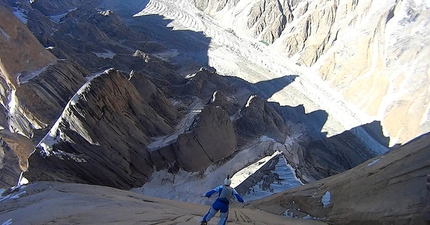
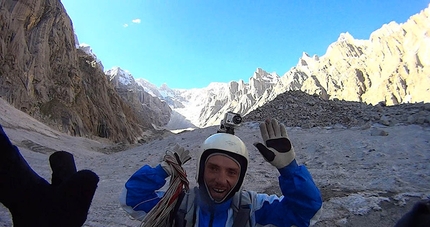
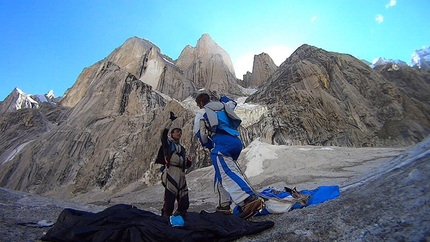
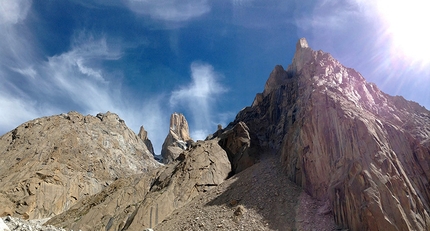
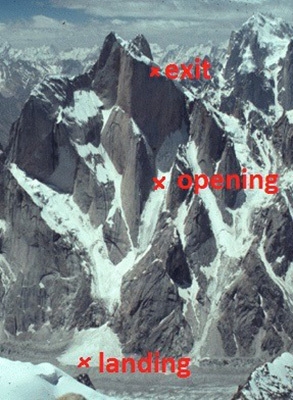
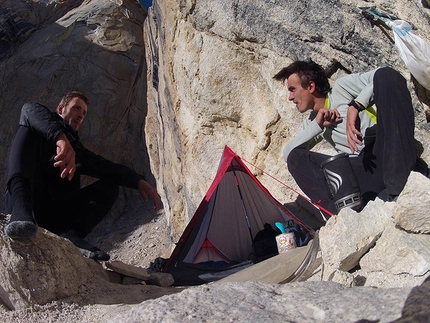
 See all photos
See all photos






















